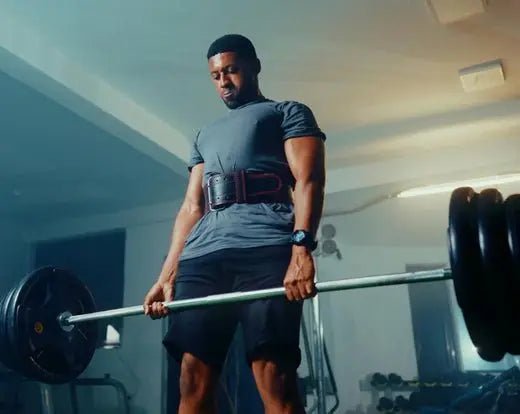
Nylon vs Leather Lifting Belts
When it comes to weightlifting, the choice of a lifting belt can significantly impact your performance and safety. Understanding the differences between nylon and leather lifting belts can help you make an informed decision that aligns with your lifting goals. Both materials have unique characteristics that cater to different types of lifters, whether you're a seasoned powerlifter or just starting out in the gym.
Choosing the Right Lifting Belt

Choosing the right lifting belt isn't just about picking the most expensive or popular option. It's about understanding your personal lifting needs, your style, and what you hope to achieve. Are you lifting for general fitness, or are you aiming to compete? Do you prefer heavy compound lifts, or do you enjoy a mix of exercises? Your answers to these questions will guide you in selecting the belt that best supports your goals. Check out premium lifting belts collection at our store.
Main Differences Between Nylon and Leather
To make an informed choice, it's crucial to understand the main differences between nylon and leather lifting belts. Let's break it down:
- Material: Leather is a natural material known for its durability and rigidity, while nylon is synthetic, offering flexibility and comfort.
- Support: Leather belts provide excellent support for heavy lifts, whereas nylon belts offer moderate support suitable for a wider range of exercises.
- Cost: Generally, leather belts are more expensive due to their durability and construction, while nylon belts are more budget-friendly.
- Adjustability: Nylon belts often feature Velcro fasteners for easy adjustments, while leather belts use prong or lever buckles for a secure fit.
- Durability: Leather belts can last for decades with proper care, whereas nylon belts are durable but may not withstand the same long-term use.
Nylon Lifting Belts

Nylon lifting belts are a popular choice among lifters who seek versatility and comfort. These belts are lightweight and easy to adjust, making them suitable for a variety of lifting styles and exercises.
Benefits and Drawbacks
Nylon belts offer several benefits that make them appealing to many lifters. They are generally more affordable than leather belts, making them accessible to beginners and those on a budget. The flexibility of nylon allows for a comfortable fit that doesn't restrict movement, which is ideal for dynamic exercises like Olympic lifts. Explore all fabric belts at our store.
However, nylon belts may not provide the same level of support as leather belts, particularly for very heavy lifts. The Velcro fasteners, while convenient, can wear out over time, potentially affecting the belt's ability to stay securely fastened during intense workouts.
Popular Nylon Belt Features
When choosing a nylon lifting belt, look for features that enhance its performance and durability. Many nylon belts come with a wide, tapered design that offers support to the lower back while allowing freedom of movement. Some belts also include additional padding for extra comfort during lifts.
Another feature to consider is the type of closure. Velcro closures are common, but some belts offer a ratchet-style fastener for a more secure fit. This can be particularly beneficial for those who engage in heavy lifting or require a more snug fit.
Best Uses for Nylon Belts
Nylon lifting belts are best suited for lifters who engage in a variety of exercises, including both compound movements and dynamic lifts. They are particularly useful for Olympic weightlifting, CrossFit, and general fitness routines where flexibility and comfort are key.
If you're a beginner or someone who prefers a versatile workout regimen, a nylon belt can be an excellent choice. It provides adequate support for most exercises while allowing you to move freely and comfortably.
Leather Lifting Belts

Leather lifting belts have long been the gold standard for serious lifters, especially those focused on powerlifting and heavy compound exercises. The rigidity and durability of leather make these belts a favorite among those who prioritize maximum support. Browse powerlifting product category.
Leather belts are often associated with powerlifting and bodybuilding, where the need for strong support during heavy lifts is paramount. These belts are designed to provide a tight, secure fit that helps stabilize the core and protect the lower back. Read more about how tight a weightlifting belt should be.
Common Leather Belt Characteristics
Leather lifting belts are renowned for their durability and robustness. Made from high-quality leather, these belts provide a rigid support structure that can withstand the rigors of heavy lifting. The leather material is often thick and sturdy, offering a firm fit that doesn’t stretch or give under pressure. This makes them ideal for providing the stability needed during maximal lifts.
Another characteristic of leather belts is their secure fastening system. Most leather belts use prong or lever buckles, which allow for a tight, adjustable fit that remains secure throughout your workout. This type of fastening ensures that the belt stays in place, providing consistent support during every lift.
Ideal Applications for Leather Belts
Leather belts are particularly well-suited for powerlifting and bodybuilding. These disciplines often involve lifting heavy weights, where the need for maximum support is crucial. Leather belts help lifters maintain proper form and reduce the risk of injury by stabilizing the core and lower back.
In addition to powerlifting, leather belts are also beneficial for exercises like deadlifts, squats, and bench presses. These compound movements require significant core engagement and support, which leather belts provide effectively. Lifters who regularly perform these exercises will find a leather belt to be a valuable addition to their training gear.
Durability and Support Comparison
- Leather Belts: Known for their longevity, often lasting for decades with proper care. They provide superior support, especially for heavy lifting.
- Nylon Belts: While durable, they may not last as long as leather. They offer moderate support, suitable for a variety of exercises.
When comparing durability and support, leather belts clearly stand out for their ability to withstand years of heavy use. The thick leather material resists wear and tear, making these belts a long-term investment for serious lifters. Their support is unmatched, particularly when it comes to heavy compound lifts.
Nylon belts, on the other hand, are designed for versatility and comfort. While they may not provide the same level of support as leather, they offer sufficient stability for most lifting activities. The synthetic material is resistant to moisture and easy to clean, but it may not hold up as well under continuous heavy lifting.
Ultimately, the choice between nylon and leather depends on your lifting style and goals. If you're lifting heavy and need maximum support, a leather belt is the way to go. However, if you value comfort and flexibility, a nylon belt might better suit your needs.
Support in Heavy Lifting

Support is a critical factor when selecting a lifting belt, especially if you're focused on heavy lifting. Leather belts excel in this area, offering the rigidity and stability needed to maintain proper form during maximal lifts. This support helps protect the lower back and core, reducing the risk of injury.
Longevity and Material Wear
The longevity of a lifting belt largely depends on its material. Leather belts are known for their durability, often lasting for decades if properly maintained. The natural leather material resists stretching and maintains its shape over time, making it a reliable choice for long-term use.
Comfort and Fit Considerations
Comfort and fit are important considerations when choosing a lifting belt. Leather belts, while supportive, can be stiff and may require a break-in period before they feel comfortable. The rigidity of leather provides excellent support but may not be as comfortable for some lifters, especially during dynamic movements.
Nylon belts, in contrast, are more flexible and comfortable right out of the box. The softer material conforms to the body, providing a snug fit without the need for a break-in period. This makes nylon belts an attractive option for those who prioritize comfort and ease of adjustment.
Choosing Based on Lifting Goals
Your lifting goals should play a significant role in your choice of belt. Whether you're a recreational lifter or a competitive athlete, your objectives will guide you to the right belt for your needs.
Recreational vs Competitive Lifting
For recreational lifters, who may engage in a variety of exercises and prioritize comfort and versatility, a nylon belt could be the ideal choice. These belts offer sufficient support for general fitness activities while allowing for a wide range of motion.
Competitive lifters, on the other hand, often benefit from the added support and stability of a leather belt. If you're focused on powerlifting or bodybuilding and routinely lift heavy weights, a leather belt provides the necessary support to enhance performance and safety.
Budget and Cost Factors
Budget is another important factor when selecting a lifting belt. Leather belts tend to be more expensive due to their durability and construction. However, they can be a worthwhile investment for those who lift heavy regularly and need maximum support.
Nylon belts are generally more affordable, making them accessible to beginners and those on a budget. While they may not last as long as leather belts, their versatility and comfort make them a practical choice for many lifters.
Preferred Lifting Styles and Techniques
Choosing the right lifting belt is often influenced by your preferred lifting style and techniques. For those who focus on heavy compound lifts like squats and deadlifts, a leather belt provides the necessary support and stability. These belts are designed to help you maintain proper form and reduce the risk of injury during maximal lifts.
If your lifting routine includes a variety of movements, including dynamic exercises like Olympic lifts, a nylon belt might be more suitable. The flexibility and comfort of nylon allow for a greater range of motion, making it easier to transition between different exercises without sacrificing support.
Ultimately, your lifting goals and style should guide your decision. Whether you're focused on powerlifting, bodybuilding, or general fitness, there's a belt that can meet your needs and help you achieve your objectives. Read more about what size of lifting belt suits you best.
Fastening Mechanisms and Ease of Use
The fastening mechanism of a lifting belt plays a crucial role in its overall functionality and ease of use. Different belts come with various types of buckles and fasteners, each offering unique advantages and considerations.
Types of Buckles and Fasteners
Leather belts typically feature prong or lever buckles, both of which provide a secure and adjustable fit. Prong buckles are similar to those found on traditional belts, with one or more prongs that insert into holes on the belt. This allows for incremental adjustments, ensuring a snug fit tailored to your needs.
Lever buckles, on the other hand, use a lever mechanism to quickly tighten and secure the belt. This type of fastener offers the advantage of easy on-and-off access, making it ideal for lifters who need to adjust their belts frequently during workouts. The lever also provides a consistent level of tightness, which can be beneficial for heavy lifts.
Nylon belts often utilize Velcro fasteners, which are known for their convenience and ease of adjustment. Velcro allows for quick and effortless size changes, making it a popular choice for those who require flexibility and comfort. However, it's important to note that Velcro can wear out over time, potentially affecting the belt's ability to maintain a secure fit.
Impact on Secure Fit and Adjustability
The choice of fastening mechanism impacts both the secure fit of the belt and its adjustability. Leather belts with prong or lever buckles provide a tight, secure fit that remains consistent throughout your workout. This stability is crucial for heavy lifting, where maintaining proper form is essential.
Nylon belts with Velcro fasteners offer a high degree of adjustability, allowing you to easily modify the fit as needed. This can be advantageous for exercises that require a greater range of motion or when transitioning between different types of lifts. However, the trade-off is that Velcro may not provide the same level of security as a buckle, particularly for maximal lifts.
Concluding Thoughts on Belt Selection
In conclusion, the choice between a nylon and leather lifting belt should be guided by your individual needs and lifting goals. Leather belts offer unparalleled support and durability, making them ideal for heavy lifters and those focused on powerlifting or bodybuilding. They provide a secure fit that helps maintain proper form and protect against injury during maximal lifts.
Nylon belts, on the other hand, offer versatility and comfort, making them a great choice for those who engage in a variety of exercises. They are particularly well-suited for dynamic movements and general fitness routines, where flexibility and ease of adjustment are key.
Ultimately, the best belt for you is one that aligns with your lifting style, goals, and budget. By understanding the unique characteristics and benefits of each type of belt, you can make an informed decision that enhances your performance and safety in the gym.
Q: What is the main difference between leather and nylon lifting belts?
A: The main difference between leather and nylon lifting belts lies in their material properties. Leather belts are typically more rigid and offer greater durability, while nylon belts are more flexible and lightweight, making them easier to adjust and wear during workouts.
Q: Should I choose a leather or nylon lifting belt for weightlifting?
A: The choice between a leather or nylon lifting belt often depends on personal preference and the type of weightlifting you do. Leather belts are often preferred for heavy lifting due to their support, while nylon belts are better suited for versatility and comfort during dynamic movements.
Q: What are the pros and cons of leather vs nylon lifting belts?
A: The pros of leather belts include durability, support, and a traditional feel, while the cons may include a higher price and less flexibility. Conversely, nylon belts are less expensive than leather belts, lightweight, and flexible, but may not provide the same level of support as leather belts.
Q: What are the benefits of nylon belts compared to leather belts?
A: The benefits of nylon belts include their lightweight nature, comfort, and ease of adjustment. They are also generally less expensive than leather belts, making them a popular choice for casual lifters and those new to weightlifting.
Q: How do leather and nylon lifting belts affect performance in powerlifting?
A: In powerlifting, a leather lifting belt may provide better support for heavy lifts due to its rigidity. However, a nylon weightlifting belt can offer more comfort and flexibility during varied movements, which some lifters may prefer during training.
Q: Are there any specific weightlifting activities where nylon vs leather belts are preferred?
A: Yes, for Olympic weightlifting or dynamic workouts, many athletes prefer nylon belts due to their flexibility. In contrast, for exercises like squats and deadlifts, where maximum support is crucial, leather belts are often favored.
Q: Can I wear a nylon weightlifting belt for powerlifting competitions?
A: While some powerlifting competitions allow nylon belts, many strict regulations dictate the use of leather belts. It is essential to check the specific rules of the competition before deciding which type of belt to wear.
Q: How do I determine if a leather or nylon lifting belt is suitable for me?
A: To determine which belt is suitable, consider your lifting style, the types of exercises you perform, and your personal comfort preferences. Testing both types, if possible, can help you decide which feels better during your workouts.
Q: What are the care and maintenance differences between leather and nylon lifting belts?
A: Leather belts require regular conditioning to prevent drying and cracking, while nylon belts can be washed easily and typically require less maintenance. It's essential to follow the manufacturer's guidelines for both materials to ensure longevity.





